Indonesia: an economy growing strong
Also, download this story from the electronic issue here
Asia’s fourth largest economy is looking towards brighter prospects ahead, even though it is expected to slow down this year, says Angelica Buan in this report, based on interviews with exhibitors at the P&R Indonesia show, held in Jakarta late last year.
Dismantling of TPP a boon for Indonesia
Indonesia, one of Asia’s emerging economies, is undergoing an economic slowdown attributed to the global trade slump, slowdown in China’s economy and declining commodity prices as well as other internal factors. Currently, its gross domestic product (GDP) has eased from 5% in 2014 to an estimated 4.8% in 2016, according to the CIA Factbookdata. Close to this figure is the Asian Development Bank's (ADB) growth forecast for this year, conservatively placed at 5.1%, amidst “slower pick-up in investments”.
However, recent developments are indicating that the country’s economic situation will improve in the long term.
For instance, against the fact that the Trans Pacific Partnership (TPP) agreement will be dismantled, following the withdrawal of the US from the deal, under the new administration of newly-elected President Donald Trump, Indonesia would be more competitive than its other ASEAN neighbours in terms of trading with the US, which is one of its main trade partners. The US accounted for 9.4% of Indonesian exports in 2015, according to GlobalEdge of the International Business Centre at Michigan State University, US.
In terms of both domestic direct investments (DDIs) and foreign direct investments (FDIs), the country has also witnessed growth in these areas and expects to continue to perform well.
The Investment Coordinating Board of the Republic of Indonesia (BKPM) stated that in 2016, DDIs raked in over Rp 58 trillion, or an increase of 25.8%, compared to the previous year’s Rp 46.2 trillion. Meanwhile, FDIs rose by 2.1% to Rp 101.9 trillion during the same period.
Household consumption and sectors as growth drivers
Indonesia’s economy is latched on to domestic consumption as well as on government spending, which together account for 70% of the country’s GDP. Being the world’s tenth largest economy by purchasing power, according to the US Department of State, the country has remained a sweet spot for global investors, banking on its rising middle and affluent classes (MACs).
Household consumption, which contributes to more than 50% of Indonesia’s GDP, will be the main growth driver this year, according to Eric Sugandi, Chief Economist at SKHA Institute for Global Competitiveness (SIGC). He adds that direct investments and government spending will also firm up an otherwise sluggish economic performance. The manufacturing, trade, agriculture, as well as construction, transport and communications sectors, amongst others, will be the country’s building blocks from this year onwards.
Indonesia’s huge population is undoubtedly its ace in boosting household consumption. Citing data by global financial group ING in its report titled International Trade Study Indonesia, the country’s current population of 260 million is forecast to grow an additional 20 million by 2030.
According to the global trade study covering the period from 1997 to 2017, there are strong indications that the country will sustain its position as Asia’s economic hotbed.
On the export front, Indonesia is poised to be the 21st largest exporter globally, with an expected growth of 15.2% a year to US$469 billion. This year, about 62% of the total exports will consist of food, fuel and other mined products.
Meanwhile, the country is taking the 20th largest global importer spot with imports growing an average of 18.4% per year to US$487 billion this year. About 45% of its imports this year will mainly comprise fuel, industrial machinery, vehicles, transport equipment, and chemicals.
Rising middle class behind a thriving plastics industry
Indonesia has the world’s fourth largest MACs segment, comprising 17.3 million households in 2014 (after the US at 25.3 million), that is forecast to expand to around 20 million households by 2030, according to Euromonitor International. In other words, MACs will double or reach 141 million individuals by 2020 (from 74 million in 2013), says the Boston Consulting Group (BCG). Euromonitor also sized up Indonesia’s median disposable income that will reach US$11,300 per household by 2030.
Armed with a strong purchasing power, this consumer segment not only wields opportunities in various product and service sectors, but also backs the domestic market for key industries, including plastics.
The plastics industry, likewise, is buffered by strong demand from related industries that rely on plastics, such as food and beverage packaging, building/construction, household appliances, automotive parts, agriculture, and others.
At the Plastics and Rubber (P&R) Indonesia show held November last year in Jakarta, Henky Wibawa, Executive Director of the Indonesian Packaging Federation (IPF), told PRA in an interview that the plastics industry is still a gainer.
“We are still enjoying growth. But for the last three years, we have not grown at the rate that we have expected, such as how it was ten years ago when we could gain double digit growth such as 15%. In 2016, our growth rate is anticipated to be between 5%-6%.”
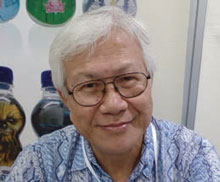
Wibawa cited a few reasons for the slow growth: impact of the global crisis; currency depreciation; lack of infrastructure; dependency on imports. “In the industry, 40-50% of our materials are still imported. And while (Indonesia) is a crude oil producer, it is not in the downstream industry; unlike countries like Singapore where they have efficient petrochemical complexes producing all sorts of materials required by the plastics sector.”
Nevertheless, economic reformation is being carried out to address these issues, he said. “We are also reforming regulations to encourage more investments and more improved import/export performance to benefit the industry,” he added.
Global confidence unchanged in Indonesia’s plastics market
Despite the uncertainties on the economic front, Indonesia’s reputation as a strong investment hub remains untarnished.
At the P&R show, the 21,500 sq m exhibition space teemed with 600 exhibiting companies from 28 countries, all tapping into Indonesia’s lucrative market.
Citing a successful turnout for the event, which is in its 29th year, Wiwiek Roberto, Project Director for show organiser PT Pamerindo Indonesia, remarked, “The participation from leading technology and solution providers clearly endorses the underlining sectors potentials and fundamentals in Indonesia and the region.”
Meanwhile, a number of the exhibitors shared their optimism for the Indonesian market.
Azo, a German
specialist in bulk
material handling
and plant automation
 equipment, attributes
the fertile market on the
country’s population
and growing middle
class. Wolfgang
Hummler, Technical
Area Sales Manager
for Azo Asia, relayed
that the company has
had a representative
office in Indonesia for
seven years. “Since
then we have focused on serving various applications
for industries including plastics, as well as food,
pharmaceutical, chemicals, and more. We specialise in
raw material handling and solutions for companies to
basically optimise and make production more efficient,”
Hummler explained.
equipment, attributes
the fertile market on the
country’s population
and growing middle
class. Wolfgang
Hummler, Technical
Area Sales Manager
for Azo Asia, relayed
that the company has
had a representative
office in Indonesia for
seven years. “Since
then we have focused on serving various applications
for industries including plastics, as well as food,
pharmaceutical, chemicals, and more. We specialise in
raw material handling and solutions for companies to
basically optimise and make production more efficient,”
Hummler explained.
Italian supplier of auxiliary equipment and automation Moretto is also eyeing opportunities in the growth sectors like automotive, medical and packaging, according to Camilla Gallato, Asia Sales Manager of Moretto.
A frequent show participant, Moretto at last year’s
event’s edition offered its latest DGM Gravix gravimetric
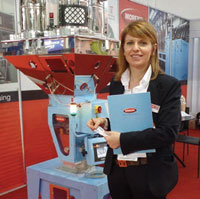 batch dosing unit. It features a number of advantages
like high precision (±0.001%), reaction speed (25 ms)
and immunity
to vibrations,
which allows it
to be installed
on blow
moulders. DGM
Gravix can be
installed as a
floor-standing
unit or on a
dedicated
frame and it is
available also
with castors,
and a special
suction tank.
The suction
valve features
adjustable and
fluidised probes.
batch dosing unit. It features a number of advantages
like high precision (±0.001%), reaction speed (25 ms)
and immunity
to vibrations,
which allows it
to be installed
on blow
moulders. DGM
Gravix can be
installed as a
floor-standing
unit or on a
dedicated
frame and it is
available also
with castors,
and a special
suction tank.
The suction
valve features
adjustable and
fluidised probes.
Similarly, Maag, Swiss manufacturer of gear pumps, pelletising systems, and melt filtration systems, has secured a niche in the Indonesian market.
Samanyar Tongnat, Marketing Manager, and Pheng
Huat Chew, Sales Manager for Maag, lauded the wide
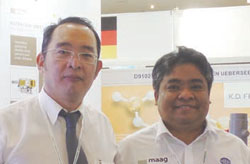 opportunities the market has unleashed to solution
providers like Maag, which sees a gold mine in screen
changers for PET, masterbatch and compounding.
opportunities the market has unleashed to solution
providers like Maag, which sees a gold mine in screen
changers for PET, masterbatch and compounding.
The company was promoting its Pearloflex underwater pelletising system for frequent product and colour changes at up to 500 kg/hour. It has been specifically designed to process a wide range of polymers and thermoplastics and produces mostly spherical pellets.
“This most efficient and flexible system is, for example, applied in the production of compounds, masterbatches, engineering plastics, wood and natural-filled polymer composites, thermoplastic elastomers and in the field of recycling,” said Chew.
F&B sector to feed advancements in packaging
Meanwhile, Indonesia’s food and beverage (F&B) industry, which contributes to nearly 34% of the GDP, is forecast to grow at 8.5% this year, citing projection by the Indonesian Food and Beverage Association (Gapmmi). The burgeoning F&B sector is a lucrative area for FDIs in Indonesia; and this growth augurs well for the packaging sector.
As observed at the P&R show, more visitors were flocking to stands where packaging machines were demonstrated.
Italian extrusion machinery specialist Amut, which has observed steady improvements in the market over the course of five years of its participation in the annual trade fair, showcased its AMP thermoforming machine series for processing PP, PET, PVC, GPPS, HIPS, materials with barrier layers and general purpose thermoplastics, as well as its packaging film, printing and converting technologies.
Andrea
Peretto, Amut
Sales Manager
& Process
Engineer,
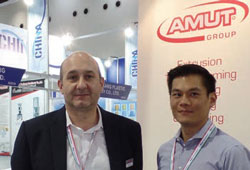 together
with Amut’s
Indonesian
representative
Harry Nugroho,
note Indonesia’s
readiness for
efficient and
price competitive
machines such
as Amut’s. “The market is aware of our machines offering
advantages that are comparable to other European
machines,” Peretto said, adding that water cup and cup
sealing machines are selling strong in the country. “We
have more than 16 lines in Indonesia, with each machine
producing an average 40-50 million cups/month,” Peretto
added.
together
with Amut’s
Indonesian
representative
Harry Nugroho,
note Indonesia’s
readiness for
efficient and
price competitive
machines such
as Amut’s. “The market is aware of our machines offering
advantages that are comparable to other European
machines,” Peretto said, adding that water cup and cup
sealing machines are selling strong in the country. “We
have more than 16 lines in Indonesia, with each machine
producing an average 40-50 million cups/month,” Peretto
added.
Lübeck-headquartered thermoforming machinery firm
Gabler Group also vouched for strong sales for water
cups in Indonesia, which it considers as currently one
of the world’s and Asia’s
biggest markets. Gabler was
promoting its latest M100
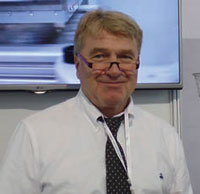 tilt-bed technology machine,
which it claimed is the world’s
largest thermoforming
machine to be featured at
last year’s K2016 exhibition
held in Germany. M100,
which has already been sold
in Indonesia, features an
improved drive system, userfriendly
HMI touchscreen,
reverse-stacker automation,
SpeedFlow forming air
system, and other features.
tilt-bed technology machine,
which it claimed is the world’s
largest thermoforming
machine to be featured at
last year’s K2016 exhibition
held in Germany. M100,
which has already been sold
in Indonesia, features an
improved drive system, userfriendly
HMI touchscreen,
reverse-stacker automation,
SpeedFlow forming air
system, and other features.
“We have sold more than 60 Gabler machines in Indonesia; and a number of machines in other countries like Malaysia, Thailand, China and Australia,” said Kay Schwarz, Managing Director at Gabler, adding that the company has a service office located in Jakarta.
Long-time Taiwanese
exhibitor Keenpro promoted
its EM 12 S2 high-speed
blow moulding machine with
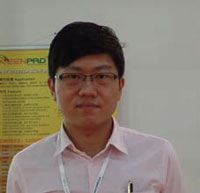 12-cavities at the show. This
machine was first launched
at the Taipeiplas exhibition in
Taiwan last year.
12-cavities at the show. This
machine was first launched
at the Taipeiplas exhibition in
Taiwan last year.
Edison Lee, Marketing Manager of Keenpro, noted that energy-savings are an important aspect when it comes to machines marketed in Indonesia. “Our machines can provide energy savings of up to 40%, compared to other machines of a similar capability,” he said.
The company is, likewise, banking on the growing packaging market for mineral water, juice, hot tea, and edible oil. Other machines that Keenpro is pushing into the market include the LM series PET automatic stretch blow moulding machine for small-batch bottle production lines; and the EM series PET automatic stretch blow moulding machine featuring integrated advanced functions.
Yogurt cups, meanwhile,
were an application focus for
US manufacturer of machinery
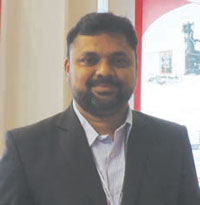 Milacron. For this application,
the company introduced its
Elektron 200 high- speed allelectric
injection moulding
machine, from the Elektron
series, said Ajay Prapajati, Deputy Manager for Milacron.
Milacron. For this application,
the company introduced its
Elektron 200 high- speed allelectric
injection moulding
machine, from the Elektron
series, said Ajay Prapajati, Deputy Manager for Milacron.
“Targeted for the production of round containers, it uses 60% less energy and 90% less water than hydraulic injection moulding machines, reducing operating costs substantially, for a better alternative for the packaging sector,” claimed Ajay.
Positive prospects ahead for plastics sector
Meanwhile, IPF’s Wibawa is pinning hopes on industries like packaging to help stimulate the market, and ultimately the economy. He emphasised the importance of developing packaging types to meet the standards of today’s consumers.
“As we enter the middle class-economy, lifestyle changes will be inevitable,” said Wibawa. He said that such lifestyle transitions may also influence the choice for consumer goods, in terms of quality and convenience. “We have smart consumers now who want to see necessary (nutritional) information on the food packaging that they buy, or if what they are buying is healthy.”
He also reiterated that consumer goods need proper packaging. “Packaging is a product differentiator that needs to also meet basic criteria such as consumer appeal, sustainability, and affordability.”
“As far as IPF is concerned, our vision is to have better packaging in Indonesia,” Wibawa continued. “We need to educate the industry and the market, to understand the importance of packaging for a product, such as what benefits packaging gives to a product.”
He said that the trade association is able to provide know-how through seminars and workshops, as well as collaborating in industry events such as the P&R exhibition.
“Indonesia has bright prospects ahead, considering its population boom, urbanisation and young people who are well educated. These factors are opening up opportunities for growth. There are yet hurdles to overcome but we are optimistic of the future,” he concluded.
(PRA)Copyright (c) 2017 www.plasticsandrubberasia.com. All rights reserved.
















































